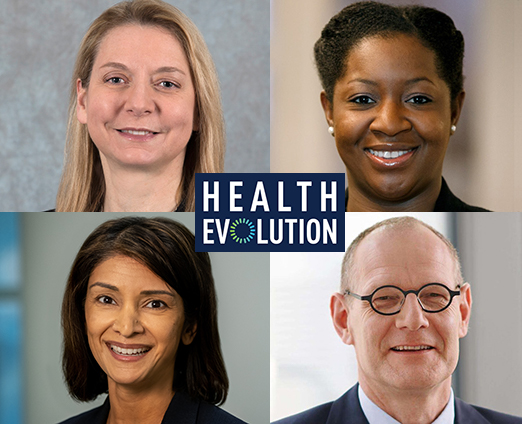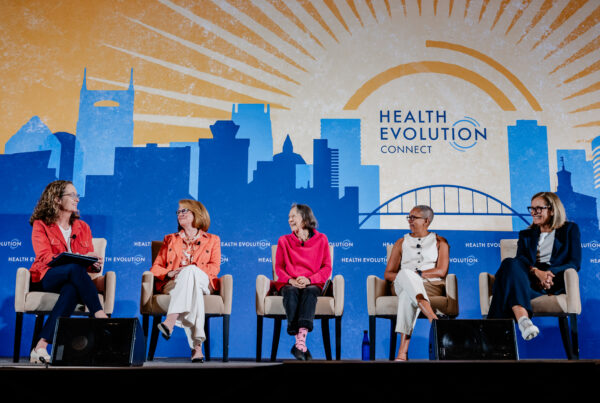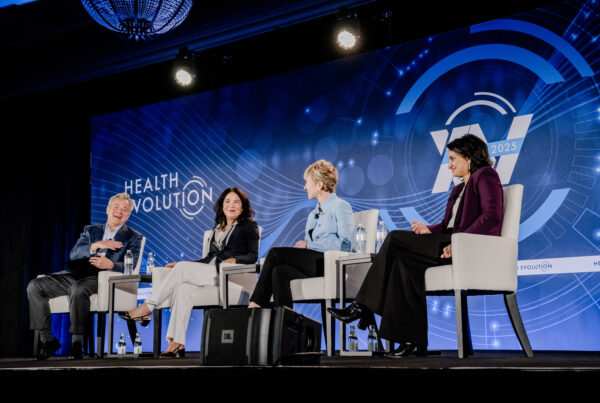Among the changes COVID-19 has either started or accelerated are unprecedented degrees of cross-industry collaboration and public-private partnership for developing therapeutics to treat people with coronavirus and, ultimately, vaccines to prevent it.
“We are reinventing the process to get therapeutics with a special urgency,” said Bernd Montag, CEO, Siemens Healthineers.
Montag hosted the Health Evolution virtual gathering, COVID-19 Therapeutic Innovation: Regulatory Policymaking and Expedited Clinical Trial Innovation. Participating in the discussion were Patrizia Cavazzoni, MD, Acting Director, Center for Drug Evaluation and Research, FDA; Esther Krofah, Executive Director, FasterCures, Milken Institute; and Ramona Sequeira, President, Takeda Pharmaceuticals USA.
The experts discussed how research and development has picked up for COVID therapeutics, the progress being made, the need for real-world evidence and whether or not some of the rapid changes being instituted will continue post-pandemic.
R&D is on the rise
“We’ve certainly seen a surge of activity when it comes to R&D in the space of both vaccines as well as therapeutics for COVID-19,” Cavazzoni said.
In response, the FDA quickly established a coronavirus treatment acceleration program that was meant to provide very focused attention for researchers, academics and sponsors looking to work with the agency to develop therapeutics, with particular attention to the pre-Investigational New Drug phase to advance drug development more rapidly.
“We encourage researchers to come and talk to us early to submit an IND to actually work through as much as possible,” Cavazzoni said. “Because we’re seeing not only very experienced entities that want to engage in development of COVID-19 therapeutics but also less experienced researchers who are navigating the regulatory process for the first time.”
Cavazzoni explained that FDA has also worked to expedite review timelines that would not be sustainable if applied to all therapeutics. “We’re working under very exceptional circumstances, and we have seen a lot of traction,” Cavazzoni added.
Since the program started in April, in fact, FDA has had more than 500 pre-IND submissions for COVID therapeutics and nearly 200 programs in the clinic that have received a Safe to Proceed letter, according to Cavazzoni. Recognizing that the researchers, sponsors and drug developers need direction, FDA also issued guidance on how to approach developing therapeutics for COVID-19, which encompasses appropriate conduct for clinical trials and the need to revise statistical analysis.
“There’s been a lot of effort when it comes to developing guidance,” Cavazzoni said.
Describing the situation as all hands-on deck, Krofah said many companies are interacting with the FDA much more than they previously had to bring forward promising therapies.
Sequeira explained that in the private sector multiple organizations formed a plasma alliance to collect plasma from recovered COVID-19 patients to more quickly reach critical mass.
“If each company was trying to collect 8,000 donations separately, each of us would still be no less than halfway there,” Sequeira added. “Because we all decided to pool our efforts, we were all able to work together and collect enough to get it into the manufacturing facility. It should be going up on ClinicalTrials.gov soon.”
At the same time that R&D is surging, regular clinical trials have also been disrupted because non-COVID patients are wary of coming into academic medical institutions and, of course, postponing elective care. FDA has worked with those companies to provide flexibility with ongoing clinical trials, whether via remote monitoring, virtual visits or other adjustments as possible, Cavazzoni said.
Therapeutic progress: It is happening
FasterCures has been tracking therapeutic and vaccine development since early March, Krofah said, at which point there were 2 or dozen compounds under review. Now, it’s approaching 400 including both therapeutics and vaccines.
“We had the early data from remdesivir, which was the adaptive clinical trial design study, that gave us some good information. It’s potentially beneficial for patients in a moderate way,” Krofah said. “That study is being added on in a study with an anti-inflammatory to see if we can have added benefit for patients particularly to study whether we can decrease mortality rates, which was not something that was initially part of the clinical endpoints.”
Krofah added that some 40,000 patients have received convalescent plasma and the early data is that it’s safe but efficacy has not been demonstrated in controlled clinical trials.
“That’s something we’re expecting to see, particularly as hospitals are realizing that may potentially need to pool data in order to have more effective results,” Krofah said.
FasterCures is also tracking monoclonal antibody development to see if a bridge therapy will emerge between now a vaccine, as well as antivirals and compounds approved for other uses, such as prostate cancer.
“Ideally, in the future we will have a vaccine and get safely to herd immunity. But even a vaccine won’t be effective in everybody,” Sequeira said. “Between now and the time that we reach herd immunity, we’re likely going to need a combination of different types of medicines. It could be some of them will be used together or used at different stages of illnesses.”
What’s needed now: Real-world evidence
With so many efforts underway to develop therapies and vaccines, evidence of what works and what does not is, of course, critical.
“Our knowledge of COVID 19 has changed over time. How to construct clinical trials has changed,” Sequeira said.
Krofah added that many organizations are working to collect real world evidence by compiling data from EHRs, patients, clinical trials and other sources for a more comprehensive understanding.
“There is utility in using real-world evidence to evaluate the utilization of certain therapeutic modalities that may not be easily evaluated in clinical trials, because they have become the standard of care, and they’re working,” Cavazzoni said.
Cavazzoni pointed to steroids and anticoagulants as examples. The FDA has learned that there are efforts to study anticoagulants in clinical trials and FDA is hearing from the field that anticoagulants are being used as a de facto standard of care in patients with severe COVID disease. Even if the practice is technically working, it is difficult to study that in a randomized clinical trial setting.
“We need to make sure that the data are fit for purpose,” Cavazzoni said. “We need to make sure that the methodology that is utilized is not only a rigorous, but it’s also transparent.
Will the collaboration continue after COVID-19?
Krofah said that what’s happening right now is actually an acceleration of the work before COVID. “This is not going to be just for this month of time,” Krofah added. “The collaborations will continue at a brisk pace over the next few months to years ahead.”
Siemens’ Montag added that health care as an industry has embraced different styles of interaction, learned to be agile and should work together to emerge stronger “and not waste the crisis.”
“We need all of these things to be happening right now to manage the impact on people and on the health care system. Because we don’t know what’s going to work and what isn’t going to work,” Sequeira said. “The more things that we can try and assess, the better.”
Sign up for an on-demand recording of this webcast here:










